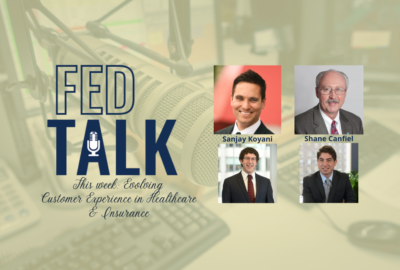Hubbard Radio Washington DC, LLC. All rights reserved. This website is not intended for users located within the European Economic Area.
Brace yourself for the return of federal long-term care insurance options
Federal employees have not been able to purchase long-term care insurance for the past couple of months. That's because the Office of Personnel Management suspe...
Federal employees have not been able to purchase long-term care insurance for the past couple of months. That’s because the Office of Personnel Management suspended the program, pending the new plans and prices that are expected from the carrier. It is likely to be very expensive. For what to expect, Federal Drive with Tom Temin spoke with the with John Hatton, the policy vice president at the National Active and Retired Federal Employees Association.
Interview Transcript:
Tom Temin John, let’s talk about the impending premium increases for federal long term care insurance. I mean, that whole industry is a little bit dubious right now, not just in the federal market, but generally is that the premiums going to keep going up? Where are they now? What’s been happening? And is there really a future for the whole idea?
John Hatton Well, it’s a good question. Just to start with, where the federal long term care insurance program is, they’ve been operating on seven year master contracts between OPM and the insurer John Hancock that will allow premiums to go up every seven years. And they have enrollees when they enrolled in the program. We’re told that these were the premiums, that they hope to stay stable. Now they can go up on a class basis to insure the solvency of the fund. But there’s that kind of fine print contractual language, but it’s gone up to such a degree that it’s hard to think any reasonable person could have predicted such a high premium increase. And so this newest contract renewal started in May. Enrollees are going to start receiving letters indicating their premium increases this week, the week of Sept.11, and then they will have 60 days to make choices on whether to accept that premium increase or to take some reduced coverage as low as just getting coverage for the amount of premiums they paid. We don’t know the total amount, OPM has not released that. They had released that in the past. The last time premiums went up, they went up as high as 126% and 83% on average. So I’m expecting another huge premium increase, which is going to be very difficult for people to accept.
Tom Temin 83% was the average.
John Hatton Last time. So we don’t know, this time we had no numbers on the amount. I generally think that they’re not releasing the numbers that’s a bad sign for how high it will be. And so we’ll have to see and get it based on anecdotal reports from our members, kind of the range of what the premium increases are going to be. So I think you’re right when you say this has happened in other long term care plans, there’s not a lot of group long term care insurance. There’s CalPERS, I think there is one in Minnesota. They’ve experienced similar high premium increases. If you purchased a private sector plan, it’s just long term care insurance. Those have also had premium increases. One of the things that kind of came out in a study of this program compared to the private sector alternatives, is a couple of things that are unique that I think are bothersome, which is, one, they take into account the investment returns or lack thereof of the insurer when setting these premiums, and they still have this guaranteed profit structure. Whereas in the private sector, those plans were on the hook for potential losses in a greater way, I think, than the insurer has been insulated from them here. And for them to still be having some guaranteed profit while these premiums continue to go up. And I think it’s becoming harder and harder for enrollees to accept, especially when these are guaranteed renewable contracts. So I think taking a look at that and what the justification is for these continued profits with these high premium increases is something we’d like to see.
Tom Temin Yeah, I guess really the dynamic here is that unlike House Insurance or something, a tiny percentage of houses are lost by fire or flood. And so the profile is known of what’s going to happen. Insurance probably a much higher percentage of the population is getting to the point where they need long term care insurance. And so you have, instead of a premium to payout ratio of maybe a million to 1 or 100,000 to 1, it’s maybe 10 to 1.
John Hatton It’s a little bit more of an investment and a little bit more similar to life insurance, particularly whole life insurance. Now, whole life insurance you’re going to collect on right. And long term care, I think the percentage is around 50%. So it’s not quite there, but it is a little bit more of an investment and protection of your assets for your heirs as compared to, let’s say, plan for contingency that you may have this eventuality when it’s very likely you will. So it’s just turned out that, look, it’s still a very valuable coverage. It’s still something everybody should be planning for and have something in the works. But I think what’s difficult for enrollees is they were planning, they did put the money away, and now it’s either unaffordable to continue paying these premiums or they’re left with coverage that they feel is inadequate for what their needs are going to be. And so if people were over insured already and maybe they can reduce those premiums or keep the premiums flat and keep lower coverage. But again, they’re still worse off in this situation.
Tom Temin Also, the coverage that is the benefit of these plans is also going down. They used to cover as long as you needed the care, you were insured for it. Now it’s 36 months maximum or 24 months maximum. The idea is the insurance company presumes you’ll say goodbye permanently instead of running up seven years of insurance.
John Hatton Usually offer coverage and newly offer coverage has been suspended and felt set. But outside of gossip, you’d have that people will have the choice of whether to take these reduced coverage. So they may have this choice to take the increased premiums, but keep the same higher coverage. So there’s not a force and change of coverage for individuals here, but they may just be paying astronomical amounts in premiums for that covers it’s no longer being offered to people newly now. So people are going to be forced to say take less coverage, they may be paying a lot more for it.
Tom Temin So you really have to do a calculus. If you spend 20 years paying a monthly premium, which turns out to be equal to the 24 month payment you would otherwise have for long term care, then you’re nowhere.
John Hatton Right. And so I think if people have this coverage, and I think that’s another frustrating part, they’re a little bit locked in. They can’t just take their money back and say invest it somewhere else or go back and invest it differently. But they may have a value in their coverage right now that is worth a lot. And so they’ll want to keep it. So figuring out what is the best way to keep this coverage or some percentage of that coverage for them, and then pairing it with other planning for their long term care and taking a fresh look at do I really need this total level coverage or can I combine the long term care insurance coverage with my annuity, with my savings to get to a point that I am secure in that end of my retirement?
Tom Temin Well, we’ll just have to see what those premiums look like when they come out. And maybe OPM hasn’t revealed them because they know how bad it’s going to be.
John Hatton That’s my guess. But I won’t put words in their mouth.
Tom Temin And speaking of OPM, then we are looking at all sorts of lurid possibilities for the operation of the government over the interests between Sept.30 and Oct.1 this year. And you got the idea maybe this could actually affect the retirement services, which OPM struggles to keep afloat as it is.
John Hatton Yeah, well, I think the outcome of the ultimate negotiation will implicate retirement services. And is there going to be a flat funding or is there going to be increase or is there actually going to be decrease? So the House bill would have a decrease in funding for OPM back to 22 levels. The Senate bill would increase funding by 35 million. And specifically that report language indicates that this should go to improving retirement services, improving IT modernization, and making sure the rollout of the Postal Service Health Benefits program is done correctly. And I think those all are and should be the top priorities for OPM. And so our hope is that that Senate bill language and amount of money is authorized to OPM, because we’re at a stage where it is way past time for them to modernize their systems, particularly for retirement services.
Tom Temin Right. But it’s not as if they haven’t had budget for that in the past.
John Hatton True. And I think there was once where they had a contract for multimillion dollars and totally failed to modernize the system. And so I think that had led to some backlogs, because they had reduced staff in anticipation of that in the early 2010’s. And then they solved that problem by just increasing staff and increasing overtime. And then have had this seemingly incremental approach, but there hasn’t been that much progress. And they’re looking to roll out a pilot of an online retirement application by the end of this year. And if that’s successful, hopefully do that governmentwide. That’s a really good sign for us. I don’t think there should be a paper based application system, even if you’re forced to have some paper in the process because you can’t digitize all these files at once. But just having an application where, Hey, there’s a missing document, there’s a missing field, and that alerts the person filling out the application before it gets sent over the way we do online applications today, whether it’s a basic online form or a mortgage application. I think it could help the entire process move along better. You’re going to probably have less errors coming from agencies over to OPM. And so I’m hopeful that could make some improvements.
Tom Temin Yeah, well, if every single new federal employee starting now, did everything digitally, golly, in 40 years it would all be online. We have no problem with that.
John Hatton I think the long term view is to get all the underlying forms like the SF50 forms in digitized and then integrated, but then that’s a lot much harder.
Copyright © 2024 Federal News Network. All rights reserved. This website is not intended for users located within the European Economic Area.
Tom Temin
Tom Temin is host of the Federal Drive and has been providing insight on federal technology and management issues for more than 30 years.
Follow @tteminWFED





